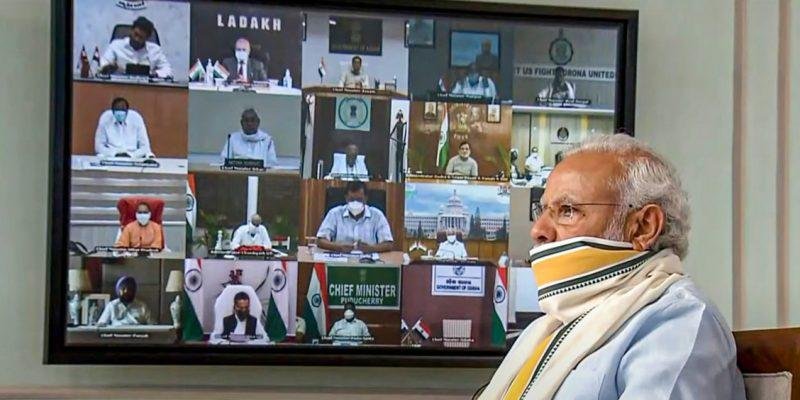The nation-wide lockdown has been functional for the past three months. And as it comes to a close, Prime Minister Narendra Modi held a virtual meeting with all the Chief Ministers to discuss the exit plan post the lockdown extension. Ever since the lockdown began, this was the fifth meeting held. The chief ministers and Prime Minister came together to discuss the future of India fighting COVID-19 after the lockdown ends.
In the previous meeting, a unanimous decision was taken to put an extension of lockdown on areas severely affected by the virus. Monday’s meet was called on to discuss the economic cycle and how the respective states plan to revive the normal activities while fighting the infection. As stated, in the previous meeting, states were divided into different zones, red, orange, and green, depending on the number of cases.
While the states continue to fight the global pandemic, officials said that the states must try reviving the economy. Cabinet secretary Rajiv Gauba held a back-to-back two-day meeting with the state chief secretaries and asked them to identify the possible areas that can be opened after 17th May. These areas are mostly the green zones, and the officials have been asked to keep a close check on these areas to ensure they remain free from the virus.

While the government is aiming at relaxing the lockdown to boost the economy, experts predict that this may lead to an increase in infection. Gauba declared that the police and health officials should come together to help people avoid the confusion of “containment areas.” In the meantime, strict actions are to be taken against those who violate the guidelines of the lockdown.
Over time, we have seen several cases where people still violate lockdown guidelines and are freely moving. This is surely one of the main reasons for the surge in COVID-19 cases in India. Apart from that, many health officials and police workers have been victims of harassment by the general public and patients. The restrictions imposed on the public is rarely being followed in many areas.
From 12th April, the train services are being started from Delhi but only to limited destinations with limited passengers. At the same time, suggestions have been given to ensure lockdown should continue around containment zones. If lockdown around the containment zones increases, the curve would increase rather than flattening.
Here’s what CMs from each state had to say
Kerala: The state should have freedom on deciding upon the lockdown extension
West Bengal: Why should the lockdown be extended when almost everything is already functioning?
Delhi: Economic Activities should begin in Normal (Green and Orange) zones, cutting out on the containment zones.
Maharashtra: The Centre should come up with strong and strict decisions for lockdown extensions, and the states would follow the guidelines.
Chhattisgarh: The Centre should offer wages for 200 days under the MGNREGA to manage the economic activities within the state.
Punjab: Lockdown should be extended, but the livelihood and interest of the everyday public needs to be taken into consideration.
Tamil Nadu: All transportation activities, especially flights and railways, should be barred from functioning until 31st May.
North-eastern regions: The governments of respective states are working in close connection with each other to combat the spread of the virus and flatten the curve.
Rajasthan: Inter-state activities mainly supply chain should be promoted.
Gujarat: Lockdown should be extended.
Home Minister Amit Shah, Defence Minister Rajnath Singh, Health Minister Harsh Vardhan, and Finance Minister Nirmala Sitharaman were also a part of the video conference.
The lockdown began on 25th May and was strictly followed. But, the cases continued to rise, and the number of coronavirus cases in India now lies at 67,000.
The coming together of state and central governments is proving to be helpful in the long run. Although the lockdown is showing results, it does have its negative impacts, such as the migrant laborers are having a tough time reaching their respective villages.
The Vande Mataram mission brought back Indians stuck in other countries, but the laborers still struggle. So, the governments are taking necessary steps to ensure everyone reaches their home safely and in time.
What the future holds is still very unclear, but the cases are being expected to lower by month-end.
If you want to be safe, you need to stay home too.




















